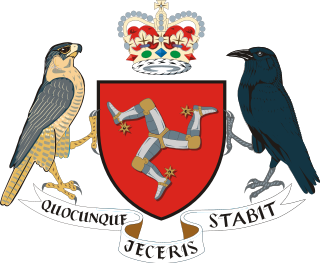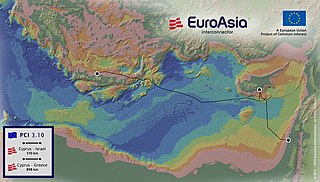The Isle of Man has an extensive communications infrastructure consisting of telephone cables, submarine cables, and an array of television and mobile phone transmitters and towers.
Ervia, previously known as Bord Gáis or Bord Gáis Éireann, is a multi-utility company distributing pipeline natural gas, water services and dark fibre services in Ireland. The state-owned company has built an extensive network across Ireland.
The Isle of Man to England Interconnector is a submarine power cable connecting the transmission system of the Manx Electricity Authority to that of Great Britain. With an undersea section of approximately 104 km, it is the second longest AC undersea cable in the world. It was laid in 1999 between Bispham, Blackpool, England, and Douglas Head on the Isle of Man, commencing commercial operations in November 2000. It is capable of continuous operation of 40 MW at 90 kV

Icon Water Limited, trading principally as Icon Water, is a water and wastewater public utility that is an Australian Capital Territory-owned corporation. The company provides drinking water and wastewater services to the ACT. Icon Water is also a 50% owner of ActewAGL, a multi-utility provider of electricity and gas services in the ACT and south-east New South Wales. Icon Water Limited is also the owner of Bendora Dam, Corin Dam, Cotter Dam and Googong Dam in New South Wales. Water is gravity fed to Canberra via the Bendora Gravity Main and pumped from Googong Dam. Icon Water operates, and maintains 50 service reservoirs, 25 pump stations, 2 water treatment plants, 27 sewage pumping stations, 4 sewage treatments plants, over 3,400 km of sewer pipelines and over 3,400 km of water pipelines.
The East–West Interconnector is a 500 MW high-voltage direct current submarine and subsoil power cable which connects the Irish and British electricity markets. The project was developed by the Irish national grid operator EirGrid.

The Isle of Man Government is the government of the Isle of Man. The formal head of the Isle of Man Government is the Lieutenant Governor, the personal representative of Elizabeth II. The executive head is the Chief Minister.

Southern Water is the private utility company responsible for the public wastewater collection and treatment in Hampshire, the Isle of Wight, West Sussex, East Sussex and Kent, and for the public water supply and distribution in approximately half of this area. Some areas within the Southern Water region are supplied by a number of smaller water supply companies. Southern Water supplies an area totalling 4,450 sq. km. and serves 2.26 million customers.
The Melbourne and Metropolitan Board of Works (MMBW) was a public utility board in Melbourne, Australia, set up in 1891 to provide water supply, sewerage and sewage treatment functions for the city. In 1992, the MMBW was merged with a number of smaller urban water authorities to form Melbourne Water. MMBW was abolished in 1992.

North West Water officially came into existence in the summer of 1989 as part of the privatisation of the water industry in England and Wales. It was a water supply, sewage disposal and sewage treatment company serving North West England. It merged with NORWEB in December 1995 to form United Utilities.
The utility infrastructure of London, England comprises a range of services and facilities that support and enable the functioning of London as a world city. Infrastructure includes facilities associated with products and materials that are consumed such as electricity, gas, water, heating and liquid fuels; materials that are produced such as sewage and solid waste; and facilities that enable communication and connectivity – telecommunications.

The Sulby Reservoir is the largest reservoir or lake in the Isle of Man, with an area of 154 acres (62 ha).
The Manx Electricity Authority was a Statutory Board of the Isle of Man Government which generated and supplied electricity for the Isle of Man. In 2014 it became part of the Manx Utilities Authority when it was merged with the Isle of Man Water and Sewerage Authority.

The Isle of Man Water and Sewerage Authority was the statutory board responsible for water supply and sewage disposal in the Isle of Man. It was formed in 1972 as the 'Isle of Man Water Authority' by the merger of the Isle of Man Water Board and the Water Department of Douglas Corporation. In 1974 it took over the gas production and distribution functions of the Isle of Man Gas Authority, and was renamed the 'Isle of Man Water and Gas Authority'. In 1985 the gas undertaking was privatised, and the authority reverted to its original title. It was renamed the 'Isle of Man Water and Sewerage Authority' in 2010, taking over the sewerage responsibilities of the former Department of Transport.
The electricity sectors of the Republic of Ireland and Northern Ireland are integrated and supply 2.5 million customers from a combination of coal, peat, natural gas, wind and hydropower. In 2018 natural gas produced 51.8%, while wind turbines generated 28.1%, coal 7%, and peat 6.8% of Ireland's average electricity demand. In 2020 wind turbines generated 36.3% of Ireland's electrical demand, one of the highest wind power proportions in the world. While the United Kingdom was one of the first countries in the world to deploy commercial nuclear power plants, the island of Ireland has never had a nuclear power plant built on either side of the Irish border. Nuclear power in Ireland was discussed in the 1960s and 1970s but ultimately never phased in, with legislation now in place explicitly forbidding its introduction.

The EuroAsia Interconnector is a proposed HVDC interconnector between the Greek, Cypriot, and Israeli power grids via the world's longest submarine power cable. Connecting Kofinou, Cyprus to Hadera, Israel and Korakias, Crete, Greece and stated to finish construction in 2023, the EuroAsia Interconnector is a major Project of Common Interest of the European Union and a priority Electricity Highway Interconnector Project, as an energy highway bridging Asia and Europe. Regulatory approval of electricity interconnection between Cyprus and Greece was completed on October 10, 2017.
The Western HVDC Link is a high-voltage direct current (HVDC) undersea electrical link in the United Kingdom, between Hunterston in Western Scotland and Flintshire Bridge in North Wales, routed to the west of the Isle of Man. It has a transmission capacity of 2,250 MW and became fully operational in 2019.
Accrington power station was a coal and refuse fired electricity generating station located in the centre of Accrington, Lancashire. The station supplied electricity to Accrington and to Haslingden and the Altham and Clayton-le-Moors areas between 1900 and 1958.
Gas for lighting and heating has been supplied to users on the Isle of Man starting in 1836; first as town gas, then as liquefied petroleum gas (LPG), and since 2003 natural gas has been available. The future use of hydrogen as a supplementary or substitute fuel is being studied.
The United Kingdom, Ireland and the Isle of Man are interconnected by five subsea and overland gas pipelines. These provide facilities for the transfer of natural gas from sources in Scotland and England to consumers in Northern Ireland, the Republic of Ireland, and the Isle of Man.







